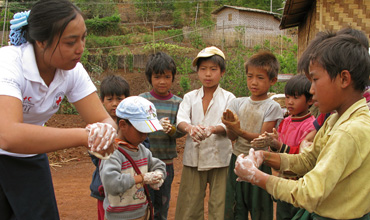Hygiene and Sanitation Practices in the Collection, Treatment and Preservation of Potable Water in Santa Town, North West Cameroon.

Abstract:
Access to safe drinkable water has improved over the
last decades in almost every part of the world, but approximately one billion
people in Africa still lack access to safe water and over 2.5 billion lack
access to adequate sanitation. In large parts of the world, humans have
inadequate access to potable water and use sources contaminated with disease
vectors, pathogens or unacceptable levels of toxins or suspended solids.
Drinking or using such water in food preparation leads to widespread acute or
chronic illnesses and it is a major cause of death and misery in many
countries. As such prevention of water borne diseases is a major health goal in
developing countries (Fawell J & Chipman K, 2010).
The health burden of poor water quality is enormous
with an estimated 37.7million individuals affected by water-borne diseases;
annually 1.5 million children are estimated to die from diarrheal-related
diseases each year (WHO, 2012).
The developing countries in the world still face the
problem of water scarcity with Africa having the largest number of countries
encountering these problems. Due to water scarcity, many families tend to store
water in their home for long term use. Most families have inadequate knowledge
or are ignorant on the duration of the storage and the type of container or
vessel used in the collection and storage of drinkable water.
Inhabitants in Santa town in North West region of
Cameroon experience inherent episodes of water shortages all round the year
prompting household to fetch, store and consume water from doubtful sources.
A study was carried out to assess the knowledge and
practices of the inhabitants of Santa town in the collection and preservation
of potable water in order to avert the occurrence of water-borne diseases.
Primary data was collected with the use of a
structured questionnaire with open and close-ended questions, administered by
the researcher and co-researchers to the study population in the randomly
selected quarters using cluster sampling. A sample size of 110 households was
recruited for the study.
Results show that 68 (58.18%) of respondents defined
drinkable water as water safe enough to be consumed with low risk of harm, 24
(21.8%) defined it as water which originates from pipe borne water while 16
(14.5%) said that it is water from any natural source.
On the criteria used in the identification of unsafe
water, 68 (58.18%) said they
identified water which is not safe for drinking from its color, taste and odor;
on the issue of water protection and preservation from contaminants, 58(52.7%)
of the responses were that they lacked containers for their drinking water,
32(29.5%) said they lacked chemicals and filters to treat their water, while
14(12.9%) did not have knowledge in the protection and preservation of potable
water while 06 (5.5%) said that the problem they encountered was the presence
of children playing around drinkable water sources and water storage
containers.
From the data collected, and analysis made it be can
be concluded that there exist inadequate knowledge on the protection and
preservation of potable water. Their understanding of the notions of hygiene
and sanitation, the knowledge and practices on the collection and preservation
of potable water are not based on the level of education but on how much public
health information they got about drinking water collection, treatment and
preservation. So, an up-to-date, knowledge and practices on the collection,
treatment and preservation of potable water is necessary for the wellbeing of
the Santa community. The Council’s hygiene and sanitation service should take
it as duty function to organize regular public health education lectures in
social institutions in order to enlighten the community.
References:
[1]. Dorothy. L. Miner (1996) .Water Quality and Waste Management.
[2]. Fawell J, Stanfield G (2010). Drinking water quality and health
http://www.wikipedia.org/drinking
[3]. Fawell J, Chipman K.(2010). Endocrine Disrupters, Drinking Water
And Public Reassurance. Water environ manage;
[4]. Folifac. F. (2013). Integrated Watershed Management in Cameroon. http://projets.tiguets.org/watermngmt
[5]. Gleick, P.H et al (2007).
The world’s water: Biennial Report on Fresh Water Resources. Chicago: Island
Press.
[6]. Goss.M, Richard C (2008). Source Water Protection Planning, which
supports the education of pathogens from agricultural activity entering water
resources.
[7]. Harrigan-Farrelly J. (2012). Status of Source Water Protection,
Ground Water Monitoring And Remediation.
[8]. Hillie, T. et al. (2006).
Nanotechnology, water, and Development. Dillon, Meridian institute.
[9]. Hoxie NJ, Davis JP et AL (1997) cryptosporidiosis-associated
mortality following a massive waterborne outbreak in Milwaukee, W isconsin.AMJ Public Health.
[10]. Hunter P. (1997), Waterborne Diseases. Epidemiology and Ecology. Chichester: Wiley.
http://www.everpure.com/issues/iow9000.htod
[11]. Kumar.S.G, Jayarama.S (2009). Issues related to sanitation failure
in India and future perspective 2009; 13-104.
[12]. Mackenzie et al (1994).
A massive outbreak in Milwaukee of cryptosporidium infection transmitted
through the public water supply. New
England Journal of Medicine 331,161-167.
[13]. Meinhardt, P.L. (2010). Recognizing water borne disease and the
health effects of water pollution: American Water Works Association and Amot
Ogden Medical center (Accessed on October 1, 2004 at www.water health
connection.org)
[14]. Pandve, T. (2008). Environmental Sanitation: An ignored issue in
India. India J.Occup Environ Med.2008,
page 12-40.
[15]. World Health Organization (2003).Guidelines for Drinking water
Quality, 3rdedn.
www.who.int/water_sanitation_health/GDWQ/draftchemicals/list.htm. Last accessed
June 2003.Geneva: WHO.

